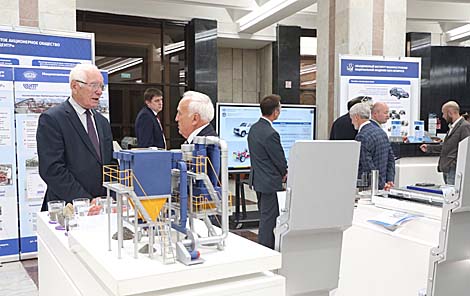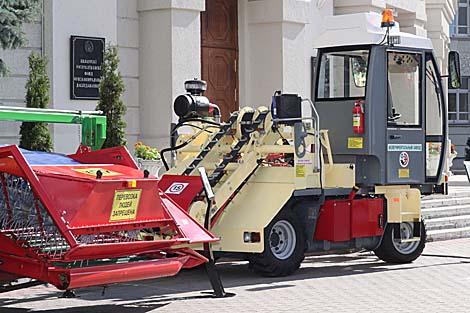Press releases
Prime minister examines latest R&D products of Belarus’ Academy of Sciences

MINSK, 5 September (BelTA) – Prime Minister of Belarus Sergei Rumas visited the National Academy of Sciences of Belarus on 5 September and was made familiar with the latest R&D products made by Belarusian scientists, BelTA has learned.
Nineteen leading organizations of the National Academy of Sciences of Belarus presented about 100 new R&D products and innovative products and technologies. The Joint Mechanical Engineering Institute of the National Academy of Sciences of Belarus showcased a prototype of the electric car Geely SC7. The model is intended to transport individuals inside a city. It can be used in taxi service or car sharing service.
The electric car’s maximum travel distance is 100km but instructions have been given to raise the figure to 500km. The prime minister also saw a prototype of the commercial electric van based on the Joylong EF5 van. It is intended to be used as a company car or a taxi car. It can transport five to seven passengers for up to 300km. The vehicle is equipped with a fast charging system. Scientists say the investment can be recouped within three years. Power equipment components of the electric car have been designed and made in Belarus. Specialists of the institute are now busy designing an electric truck.
Sergei Rumas gave instructions to calculate the cost of using Belarusian electric car and compare it to the cost of using a conventional car. “Certainly, we are interested in getting more enterprises and devices to use considerable amounts of electricity but it is not a goal by itself. We want the entire process to be economically expedient,” he stressed.
 The prime minister examined the lineup of compact Belarusian electric vehicles such as bicycles, scooters, and motorcycles. Plans have been made to rent them out in the Botanical Gardens in Minsk and in nature reserves. Scientists also presented a compact municipal vehicle designed to sweep streets and yards, remove snow, and distribute deicing agents.
The prime minister examined the lineup of compact Belarusian electric vehicles such as bicycles, scooters, and motorcycles. Plans have been made to rent them out in the Botanical Gardens in Minsk and in nature reserves. Scientists also presented a compact municipal vehicle designed to sweep streets and yards, remove snow, and distribute deicing agents.
 The drone R&D center of the National Academy of Sciences of Belarus came up with a number of flying drones designed to serve various purposes. They are designed to provide video surveillance of a territory, escort moving objects, determine their coordinates, and feed video data to a control station on the ground and other remote users. Sergei Rumas was told that in addition to drones for the Emergencies Ministry the drone R&D center is working on assault drones for the Defense Ministry. Plans are in place to design drones, which will be able to detect and evaluate the drying of forests or heat losses in buildings.
The drone R&D center of the National Academy of Sciences of Belarus came up with a number of flying drones designed to serve various purposes. They are designed to provide video surveillance of a territory, escort moving objects, determine their coordinates, and feed video data to a control station on the ground and other remote users. Sergei Rumas was told that in addition to drones for the Emergencies Ministry the drone R&D center is working on assault drones for the Defense Ministry. Plans are in place to design drones, which will be able to detect and evaluate the drying of forests or heat losses in buildings.
 The Academy’s Informatics Institute demonstrated a prototype of the office supercomputer, which runs special software, and a system for the remote monitoring of agricultural crops in an agricultural enterprise. Specialists of the Geoinformation Systems enterprise of the National Academy of Sciences of Belarus said they are designing a Belarusian-Russian satellite for taking pictures of Earth’s surface in visible and infrared spectrums. It will also be able to send video data for state and commercial purposes.
The Academy’s Informatics Institute demonstrated a prototype of the office supercomputer, which runs special software, and a system for the remote monitoring of agricultural crops in an agricultural enterprise. Specialists of the Geoinformation Systems enterprise of the National Academy of Sciences of Belarus said they are designing a Belarusian-Russian satellite for taking pictures of Earth’s surface in visible and infrared spectrums. It will also be able to send video data for state and commercial purposes.
 Prime Minister of Belarus Sergei Rumas was also made familiar with products made by the agriculture mechanization R&D center. Scientists of this branch of the National Academy of Sciences of Belarus have designed all kinds of agricultural machines for specific applications such as the distribution of solid organic fertilizers or the collection of currants, chokeberries, gooseberries, and briar berries.
Prime Minister of Belarus Sergei Rumas was also made familiar with products made by the agriculture mechanization R&D center. Scientists of this branch of the National Academy of Sciences of Belarus have designed all kinds of agricultural machines for specific applications such as the distribution of solid organic fertilizers or the collection of currants, chokeberries, gooseberries, and briar berries.
Scientists of the B.I. Stepanov Physics Institute informed Sergei Rumas about their unique R&D products, including an air plasma jet generator designed for sterilization and faster healing of wounds. A terahertz-range spectrometric device for non-contact analysis of food and for detecting adulterated products, medications, hazardous substances, and weapons was presented as well.
 The National Academy of Sciences of Belarus has established R&D centers, labs, and councils for various branches of scientific work, including in association with leading companies (BelAZ, MAZ, MTZ, MMZ, Integral). A system of over 70 interdisciplinary R&D labs and cutting-edge research centers has been established. Cutting-edge enterprises have been created and operate. Systemic projects are implemented to enable the development of conventional sectors and brand new sectors and kinds of activities.
The National Academy of Sciences of Belarus has established R&D centers, labs, and councils for various branches of scientific work, including in association with leading companies (BelAZ, MAZ, MTZ, MMZ, Integral). A system of over 70 interdisciplinary R&D labs and cutting-edge research centers has been established. Cutting-edge enterprises have been created and operate. Systemic projects are implemented to enable the development of conventional sectors and brand new sectors and kinds of activities.
At present 111 organizations and the administration of the National Academy of Sciences of Belarus employ over 15,000 people. In 2018 the Academy’s organizations performed Br682.9 worth of work (109.2% as against 2017). In January-June 2019 the figure totaled Br308.2 million (111.9% as against H1 2018).







 print version
print version make home page
make home page add to bookmarks
add to bookmarks

